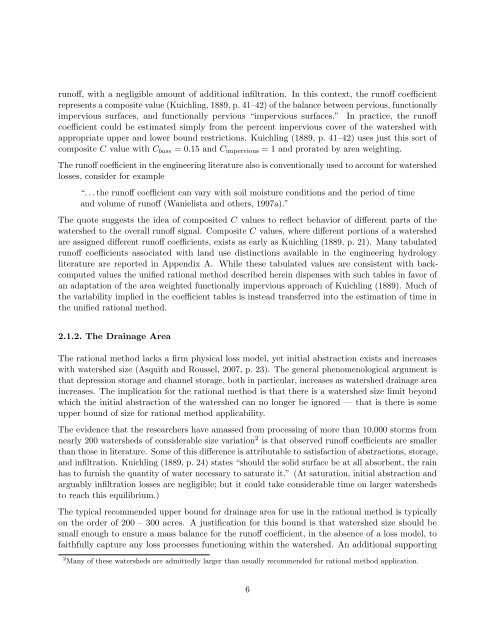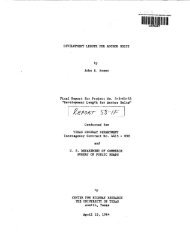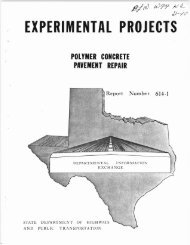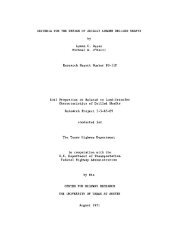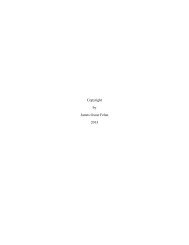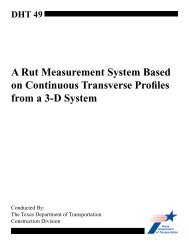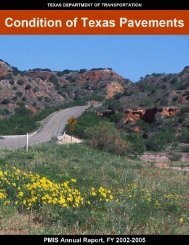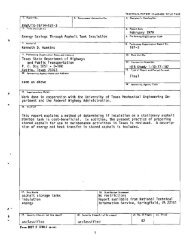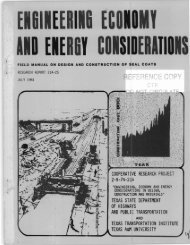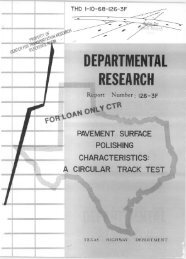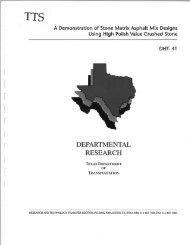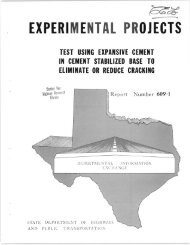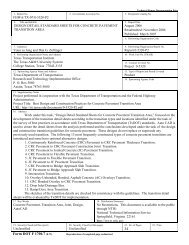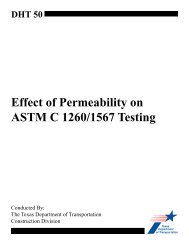Use of Rational and Modified Rational Method for ... - CTR Library
Use of Rational and Modified Rational Method for ... - CTR Library
Use of Rational and Modified Rational Method for ... - CTR Library
You also want an ePaper? Increase the reach of your titles
YUMPU automatically turns print PDFs into web optimized ePapers that Google loves.
un<strong>of</strong>f, with a negligible amount <strong>of</strong> additional infiltration. In this context, the run<strong>of</strong>f coefficient<br />
represents a composite value (Kuichling, 1889, p. 41–42) <strong>of</strong> the balance between pervious, functionally<br />
impervious surfaces, <strong>and</strong> functionally pervious “impervious surfaces.” In practice, the run<strong>of</strong>f<br />
coefficient could be estimated simply from the percent impervious cover <strong>of</strong> the watershed with<br />
appropriate upper <strong>and</strong> lower bound restrictions. Kuichling (1889, p. 41–42) uses just this sort <strong>of</strong><br />
composite C value with C base = 0.15 <strong>and</strong> C impervious = 1 <strong>and</strong> prorated by area weighting.<br />
The run<strong>of</strong>f coefficient in the engineering literature also is conventionally used to account <strong>for</strong> watershed<br />
losses, consider <strong>for</strong> example<br />
“. . . the run<strong>of</strong>f coefficient can vary with soil moisture conditions <strong>and</strong> the period <strong>of</strong> time<br />
<strong>and</strong> volume <strong>of</strong> run<strong>of</strong>f (Wanielista <strong>and</strong> others, 1997a).”<br />
The quote suggests the idea <strong>of</strong> composited C values to reflect behavior <strong>of</strong> different parts <strong>of</strong> the<br />
watershed to the overall run<strong>of</strong>f signal. Composite C values, where different portions <strong>of</strong> a watershed<br />
are assigned different run<strong>of</strong>f coefficients, exists as early as Kuichling (1889, p. 21). Many tabulated<br />
run<strong>of</strong>f coefficients associated with l<strong>and</strong> use distinctions available in the engineering hydrology<br />
literature are reported in Appendix A. While these tabulated values are consistent with backcomputed<br />
values the unified rational method described herein dispenses with such tables in favor <strong>of</strong><br />
an adaptation <strong>of</strong> the area weighted functionally impervious approach <strong>of</strong> Kuichling (1889). Much <strong>of</strong><br />
the variability implied in the coefficient tables is instead transferred into the estimation <strong>of</strong> time in<br />
the unified rational method.<br />
2.1.2. The Drainage Area<br />
The rational method lacks a firm physical loss model, yet initial abstraction exists <strong>and</strong> increases<br />
with watershed size (Asquith <strong>and</strong> Roussel, 2007, p. 23). The general phenomenological argument is<br />
that depression storage <strong>and</strong> channel storage, both in particular, increases as watershed drainage area<br />
increases. The implication <strong>for</strong> the rational method is that there is a watershed size limit beyond<br />
which the initial abstraction <strong>of</strong> the watershed can no longer be ignored — that is there is some<br />
upper bound <strong>of</strong> size <strong>for</strong> rational method applicability.<br />
The evidence that the researchers have amassed from processing <strong>of</strong> more than 10,000 storms from<br />
nearly 200 watersheds <strong>of</strong> considerable size variation 2 is that observed run<strong>of</strong>f coefficients are smaller<br />
than those in literature. Some <strong>of</strong> this difference is attributable to satisfaction <strong>of</strong> abstractions, storage,<br />
<strong>and</strong> infiltration. Kuichling (1889, p. 24) states “should the solid surface be at all absorbent, the rain<br />
has to furnish the quantity <strong>of</strong> water necessary to saturate it.” (At saturation, initial abstraction <strong>and</strong><br />
arguably infiltration losses are negligible; but it could take considerable time on larger watersheds<br />
to reach this equilibrium.)<br />
The typical recommended upper bound <strong>for</strong> drainage area <strong>for</strong> use in the rational method is typically<br />
on the order <strong>of</strong> 200 – 300 acres. A justification <strong>for</strong> this bound is that watershed size should be<br />
small enough to ensure a mass balance <strong>for</strong> the run<strong>of</strong>f coefficient, in the absence <strong>of</strong> a loss model, to<br />
faithfully capture any loss processes functioning within the watershed. An additional supporting<br />
2 Many <strong>of</strong> these watersheds are admittedly larger than usually recommended <strong>for</strong> rational method application.<br />
6


